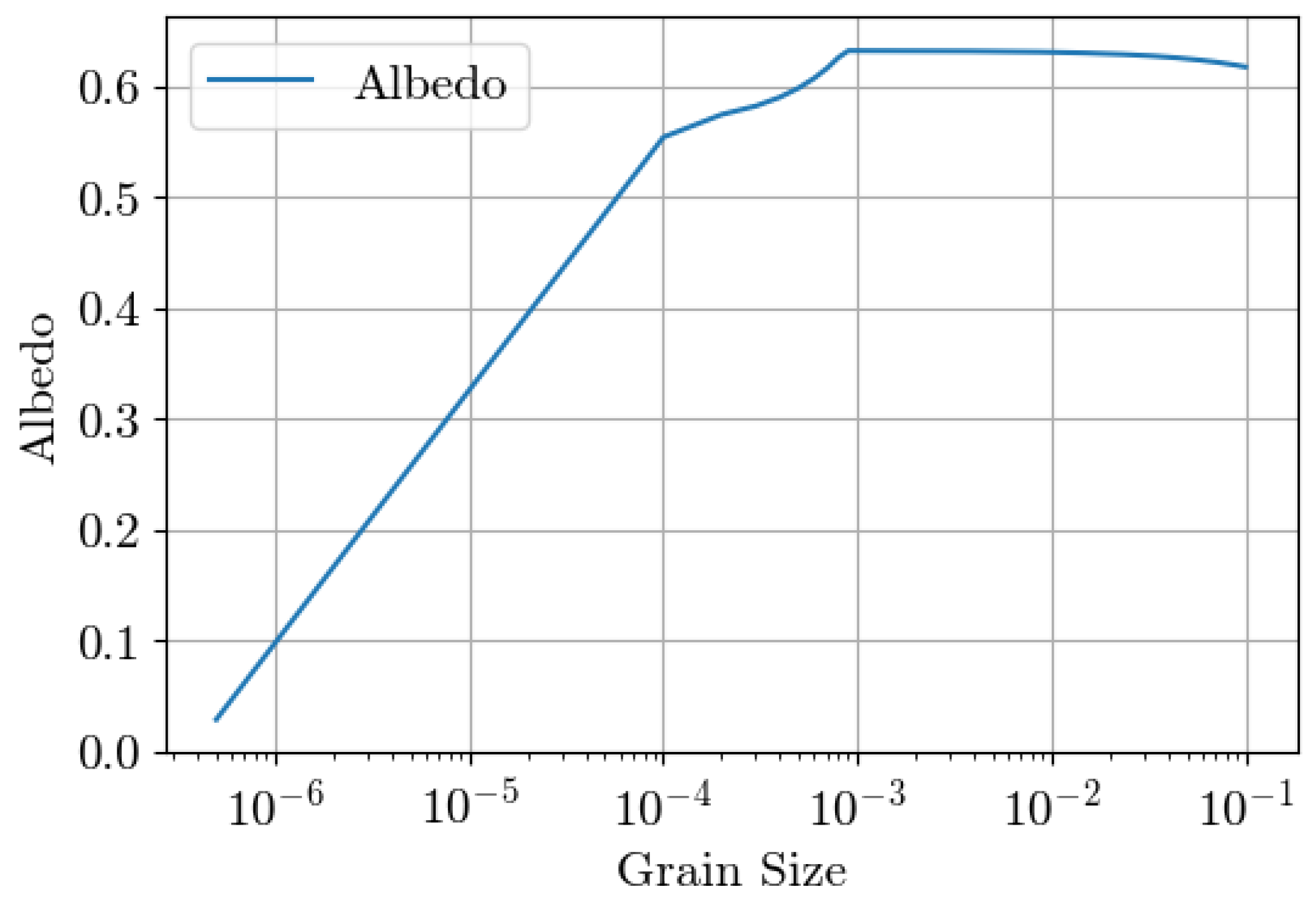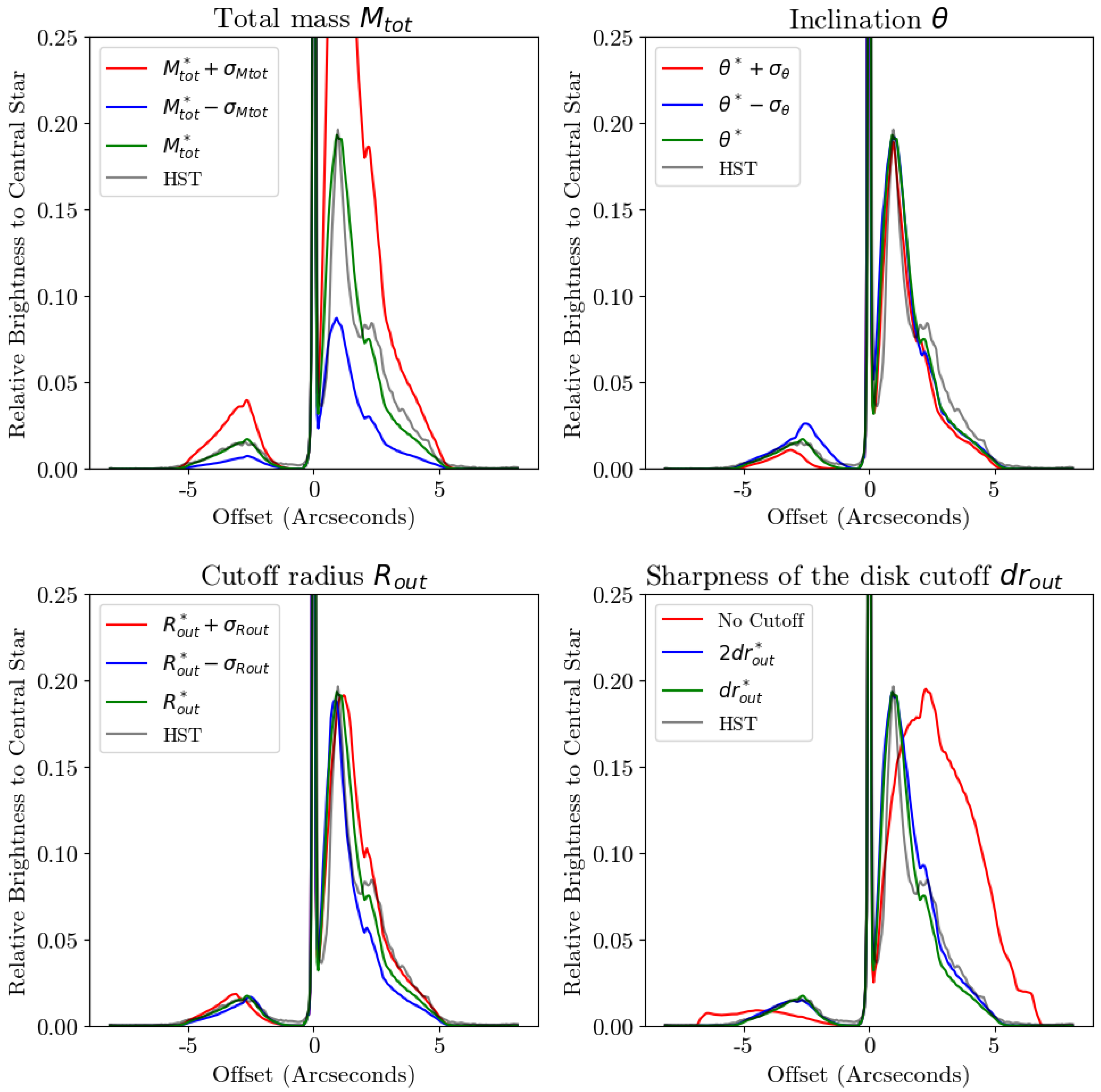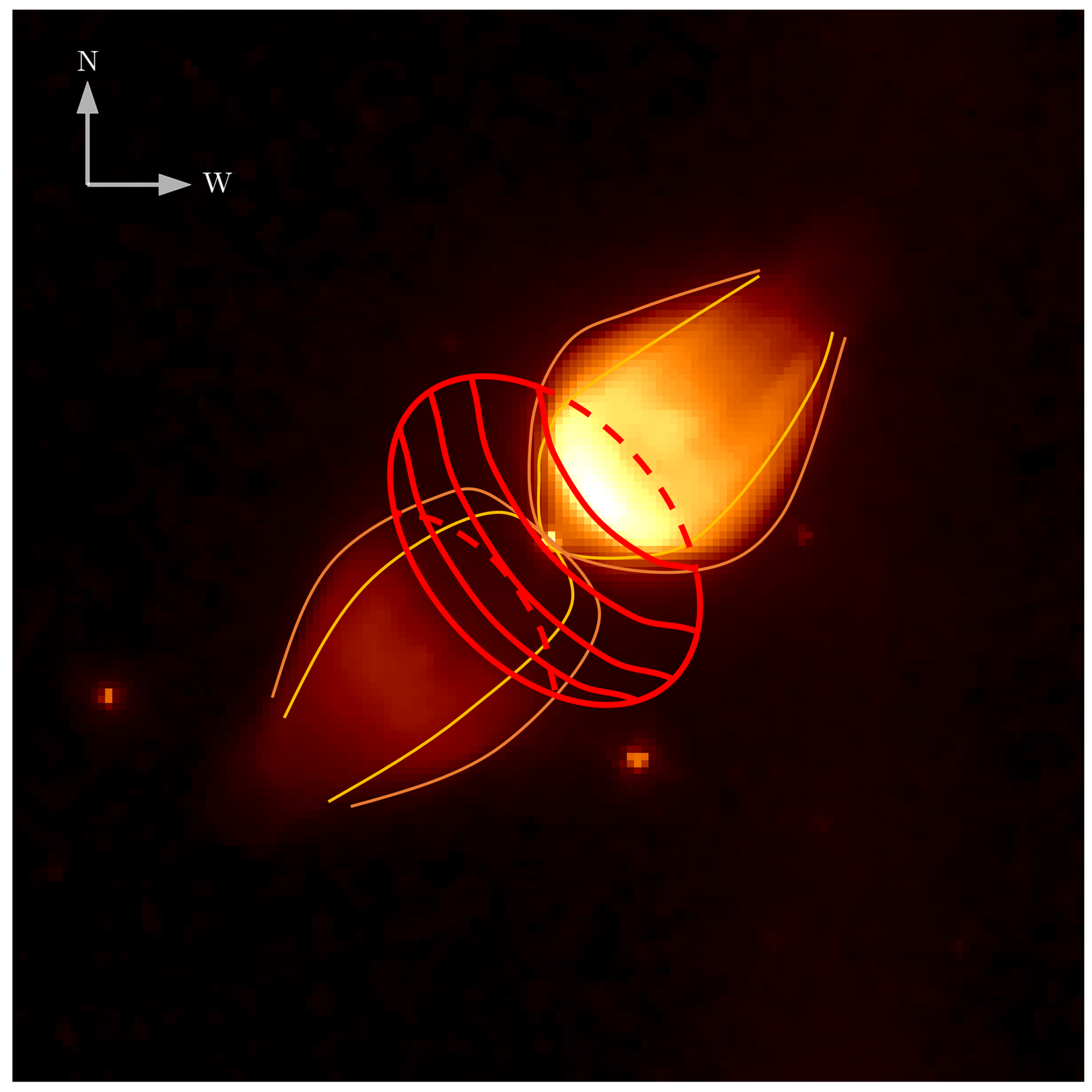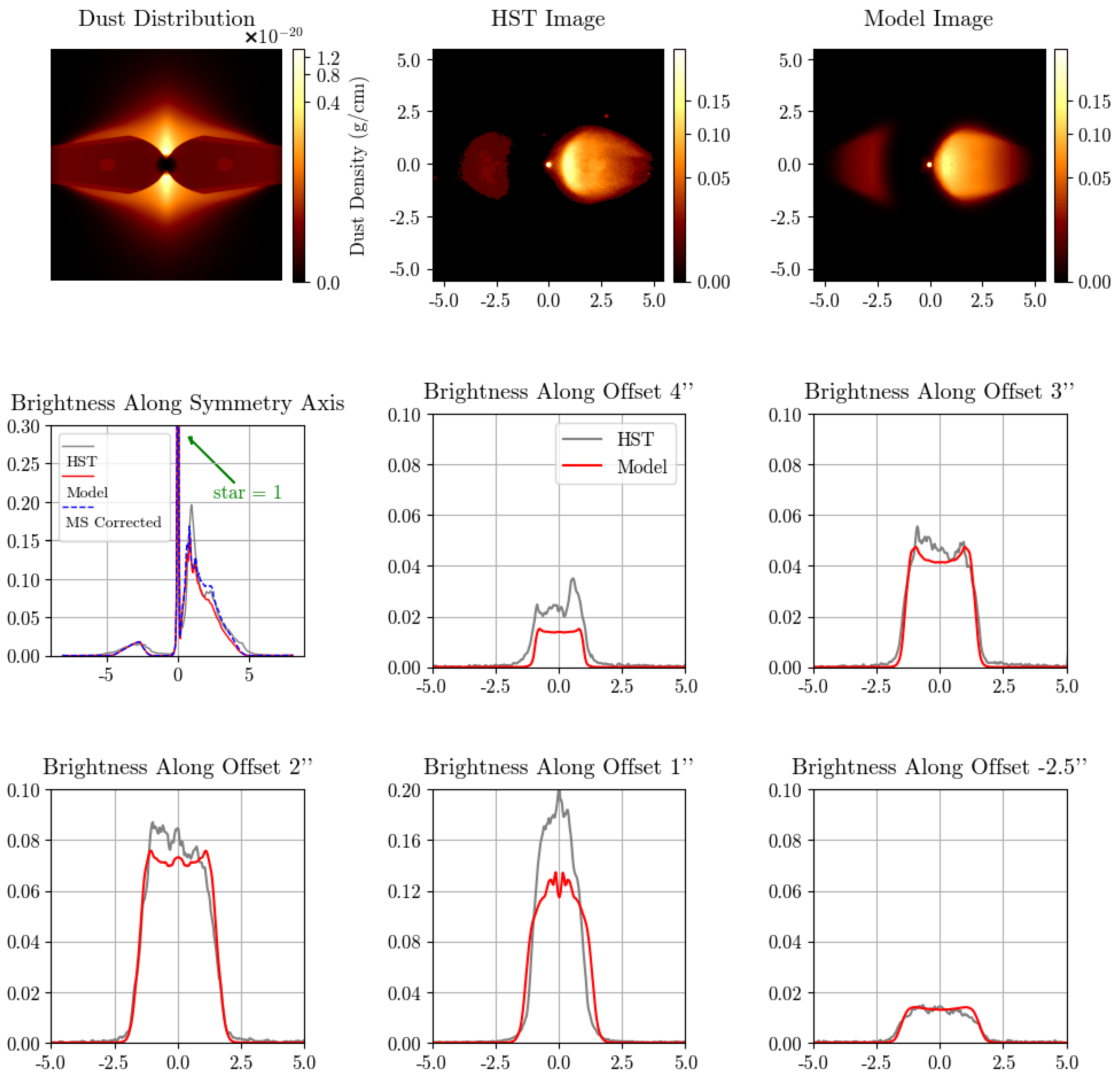A Dust-Scattering Model for M1-92: A Revised Estimate of the Mass Distribution and Inclination
Abstract
1. Introduction
2. Data
3. Methods
3.1. Dust Distribution
3.2. Radiative Transfer
4. Characteristics
5. Analysis
6. Discussion
6.1. Sharp Torus Cutoff
6.2. Inclination
7. Summary and Conclusions
Author Contributions
Funding
Data Availability Statement
Acknowledgments
Conflicts of Interest
Appendix A. Parameters
Appendix A.1. Fixed Parameters
| Parameter Definition | Value |
|---|---|
| Observing wavelength | m |
| Observer distance to nebula | kpc |
| Gas-to-dust ratio | 200 |
| Dust grain minimum size | m |
| Non-torus dust grain maximum size | m |
| Torus dust grain maximum size | m |
| Dust grain density | |
| Lobe interior outflow velocity | 500 km s−1 |
| Torus outflow velocity | 10 km s−1 |
Appendix A.2. Constrained Parameters
| Parameter Definition | Inclination Model | Inclination Model |
|---|---|---|
| Torus mass loss rate | year | year |
| Lobe mass loss rate | year | year |
| Mass loss latitude dependence | 1 | 8 |
| Asymmetry factor | ||
| Inclination | ||
| Lobe wall dust density (constant) | g/cm3 | g/cm3 |
| Ansae dust density (constant) | g/cm3 | g/cm3 |
| Conic section eccentricity—lobe wall-torus boundary | ||
| Conic section eccentricity—lobe-lobe wall boundary | ||
| Base location—lobe wall-torus boundary | cm enclosing star | 0 cm intersecting star |
| Base location—lobe-lobe wall boundary | cm enclosing star | cm enclosing star |
| Focus location—lobe wall-torus boundary | cm | cm |
| Focus location—lobe-lobe wall boundary | cm | cm |
| Transition distance—lobe wall-torus boundary | cm | cm |
| Transition distance—lobe–lobe wall boundary | cm | cm |
| Slope of the linear boundary between lobe wall andtorus | ||
| Slope of the linear boundary between lobe and lobe wall | ||
| Location of the ansa’s base | cm from the star | cm from the star |
| Location of the ansa’s focus | cm from the star | cm from the star |
| Lobe/lobe wall outer cutoff distance | cm | cm |
| Sharpness of the lobe/lobe wall outer cutoff | ||
| Torus inner cutoff distance | cm | cm |
| Torus outer cutoff distance | cm | cm to cm, elliptical |
| Sharpness of the torus outer cutoff |
Appendix B. Model Details
Appendix B.1. Dust Properties

Appendix B.2. Radiative Transfer and Multiple Scattering
Appendix B.3. Finding Optimized Parameters
| 1 | These assumptions are not crucial as the lobe interiors contribute little to the scattered light, as described in Section 6. |
| 2 | This factor is calculated as an axisymmetric spheroid with a semi-major axis of 2 and a semi-minor axis of and superimposed onto the other density calculations. |
References
- Sahai, R.; Morris, M.; Contreras, C.S.; Claussen, M. Preplanetary Nebulae: A Hubble Space Telescope Imaging Survey and a New Morphological Classification System. Astron. J. 2007, 134, 2200. [Google Scholar] [CrossRef]
- Morris, M. Bipolar Symmetry in the Mass Outflows of Stars in Transition. In Proceedings of the From Miras to Planetary Nebulae: Which Path for Stellar Evolution? Montpellier, France, 4–7 September 1990; p. 520. [Google Scholar]
- Soker, N. Jet Formation in the Transition from the Asymptotic Giant Branch to Planetary Nebulae. Astrophys. J. 1992, 389, 628. [Google Scholar] [CrossRef]
- Mastrodemos, N.; Morris, M. Bipolar Preplanetary Nebulae: Hydrodynamics of Dusty Winds in Binary Systems. I. Formation of Accretion Disks. Astrophys. J. 1998, 497, 303–329. [Google Scholar] [CrossRef]
- Morris, M. Mechanisms for mass loss from cool stars. Publ. Astron. Soc. Pac. 1987, 99, 1115–1122. [Google Scholar] [CrossRef]
- Livio, M.; Soker, N. The Common Envelope Phase in the Evolution of Binary Stars. Astrophys. J. 1988, 329, 764. [Google Scholar] [CrossRef]
- Taam, R.E.; Bodenheimer, P. Double-Core Evolution. III. The Evolution of a 5 M⊙ Red Giant with a 1 M⊙ Companion. Astrophys. J. 1989, 337, 849. [Google Scholar] [CrossRef]
- Morris, M.; Reipurth, B. The Optical Form of the Bipolar Preplanetary Nebula IRAS 09371+1212. Publ. Astron. Soc. Pac. 1990, 102, 446–453. [Google Scholar] [CrossRef]
- Livio, M.; Shankar, A.; Burkert, A.; Truran, J.W. The common envelope phase in the outbursts of classical novae. Astrophys. J. 1990, 356, 250. [Google Scholar] [CrossRef]
- Livio, M. The Common Envelope Phase in Novae (Invited Paper). Nonisotropic Var. Outflows Stars 1992, 22, 316. [Google Scholar]
- Sahai, R.; Trauger, J.T. Multipolar Bubbles and Jets in Low-Excitation Planetary Nebulae: Toward a New Understanding of the Formation and Shaping of Planetary Nebulae. Astron. J. 1998, 116, 1357–1366. [Google Scholar] [CrossRef]
- Mastrodemos, N.; Morris, M. Bipolar Pre-Planetary Nebulae: Hydrodynamics of Dusty Winds in Binary Systems. II. Morphology of the Circumstellar Envelopes. Astrophys. J. 1999, 523, 357–380. [Google Scholar] [CrossRef]
- De Marco, O. The Origin and Shaping of Planetary Nebulae: Putting the Binary Hypothesis to the Test. PASP 2009, 121, 316. [Google Scholar] [CrossRef]
- Soker, N. On the Formation of Ansae in Planetary Nebulae. Astron. J. 1990, 99, 1869. [Google Scholar] [CrossRef]
- Soker, N. Binary Progenitor Models for Bipolar Planetary Nebulae. Astrophys. J. 1998, 496, 833–841. [Google Scholar] [CrossRef]
- Ivanova, N.; Justham, S.; Chen, X.; De Marco, O.; Fryer, C.L.; Gaburov, E.; Ge, H.; Glebbeek, E.; Han, Z.; Li, X.D.; et al. Common Envelope Evolution: Where we stand and how we can move forward. Astron. Astrophys. Rev. 2013, 21, 59. [Google Scholar] [CrossRef]
- Shiber, S.; Iaconi, R.; De Marco, O.; Soker, N. Companion-launched jets and their effect on the dynamics of common envelope interaction simulations. Mon. Not. R. Astron. Soc. 2019, 488, 5615–5632. [Google Scholar] [CrossRef]
- Zou, Y.; Frank, A.; Chen, Z.; Reichardt, T.; De Marco, O.; Blackman, E.G.; Nordhaus, J.; Balick, B.; Carroll-Nellenback, J.; Chamandy, L.; et al. Bipolar Planetary Nebulae from Outflow Collimation by Common Envelope Evolution. Mon. Not. R. Astron. Soc. 2020, 497, 2855–2869. [Google Scholar] [CrossRef]
- Feibelman, W.A.; Bruhweiler, F.C. Ultraviolet Observations of the Enigmatic Bipolar Nebula M1-92. Astrophys. J. 1990, 354, 262–266. [Google Scholar] [CrossRef]
- Bujarrabal, V.; Alcolea, J.; Sahai, R.; Zamorano, J.; Zijlstra, A.A. The shock structure in the protoplanetary nebula M 1–92: Imaging of atomic and H2 line emission. Astron. Astrophys. 1997, 331, 361–371. [Google Scholar]
- Alcolea, J.; Neri, R.; Bujarrabal, V. Minkowski’s footprint revisited: Planetary nebula formation from a single sudden event? Astron. Astrophys. 2007, 468, L41–L44. [Google Scholar] [CrossRef]
- Alcolea, J.; Bujarrabal, V.; Neri, R. New Plateau de Bure observations of M1-92; unveiling the core. Astrophys. Space Sci. 2008, 313, 235–239. [Google Scholar] [CrossRef]
- Alcolea, J.; Agúndez, M.; Bujarrabal, V.; Castro-Carrizo, A.; Desmurs, J.F.; Martínez-Fernández, J.E.; Sánchez Contreras, C.; Santander-García, M. M 1–92 Revisited: New Findings and Open Questions: New NOEMA Observations of Minkowski’s Footprint. Galaxies 2022, 10, 47. [Google Scholar] [CrossRef]
- Balick, B.; Frank, A.; Liu, B. Models of the Mass-ejection Histories of Pre-planetary Nebulae. IV. Magnetized Winds and the Origins of Jets, Bullets, and FLIERs. Astrophys. J. 2020, 889, 13. [Google Scholar] [CrossRef]
- Morris, M.; Sahai, R. The Prevalence and Implications of Sharp Outer Edges of Disks in Preplanetary Nebulae, 2015. In Proceedings of the 11th Pacific Rim Conference on Stellar Astrophysics, Hong Kong, China, 14–17 December 2015; Available online: https://www.scifac.hku.hk/event/PRCSA2015/abstracts/MorrisMark.html (accessed on 24 October 2023).
- Trammell, S.R.; Goodrich, R.W. Hubble Space Telescope and Ground-based Imaging of the Bipolar Proto-Planetary Nebula M1-92: Evidence for a Collimated Outflow. Astrophys. J. 1996, 468, L107. [Google Scholar] [CrossRef]
- Gilliland, R.L. Stellar Photometry Including Saturated Images: Results on M67 with WFPC2. Astrophys. J. Lett. 1994, 435, L63. [Google Scholar] [CrossRef]
- McMaster, M.; Biretta, J. Hubble Space Telescope Wide Field and Planetary Camera 2 Instrument Handbook, Version 10.0; Space Telescope Science Institute: Baltimore, MD, USA, 2008. [Google Scholar]
- Bujarrabal, V.; Alcolea, J.; Neri, R.; Grewing, M. A Direct Image of Wind Interaction in the Post-AGB Evolution: CO Observations of M1-92. Astrophys. J. 1994, 436, L169. [Google Scholar] [CrossRef]
- Ramos-Medina, J.; Sánchez-Contreras, C.; Sahai, R.; Bujarrabal, V.; Castro-Carrizo, A.; Morris, M. Spatio-kinematics of the optical nebula M1-92 with HST/STIS. In Proceedings of the Asymmetrical Planetary Nebulae VI Conference, Online, 4–8 November 2013; p. 74. [Google Scholar]
- Mathis, J.S.; Rumpl, W.; Nordsieck, K.H. The size distribution of interstellar grains. Astrophys. J. 1977, 217, 425. [Google Scholar] [CrossRef]
- Weingartner, J.C.; Draine, B.T. Dust Grain-Size Distributions and Extinction in the Milky Way, Large Magellanic Cloud, and Small Magellanic Cloud. Astrophys. J. 2001, 548, 296–309. [Google Scholar] [CrossRef]
- Murakawa, K.; Ueta, T.; Meixner, M. Evidence of grain growth in the disk of the bipolar proto-planetary nebula M 1–92. Astron. Astrophys. 2010, 510, A30. [Google Scholar] [CrossRef]
- Draine, B.T. Physics of the Interstellar and Intergalactic Medium; Princeton series in astrophysics; University Press: Princeton, NJ, USA, 2011. [Google Scholar] [CrossRef]
- Yusef-Zadeh, F.; Morris, M.; White, R.L. Bipolar reflection nebulae - Monte Carlo simulations. Astrophys. J. 1984, 278, 186. [Google Scholar] [CrossRef]
- Henyey, L.G.; Greenstein, J.L. Diffuse radiation in the Galaxy. Astrophys. J. 1941, 93, 70–83. [Google Scholar] [CrossRef]
- Draine, B. Interstellar Dust Grains. Annu. Rev. Astron. Astrophys. 2003, 41, 241–289. [Google Scholar] [CrossRef]
- Witt, A.N.; Walker, G.A.H.; Bohlin, R.C.; Stecher, T.P. The scattering phase function of interstellar grains: The case of the reflection nebula NGC 7023. Astrophys. J. 1982, 261, 492–509. [Google Scholar] [CrossRef]
- Witt, A.N.; Oliveri, M.V.; Schild, R.E. The scattering properties and density distribution of dust in a small interstellar cloud. Astron. J. 1990, 99, 888. [Google Scholar] [CrossRef]
- Sahai, R.; Sánchez Contreras, C.; Morris, M.; Claussen, M. A Quadrupolar Preplanetary Nebula: IRAS 19475+3119. Astrophys. J. 2007, 658, 410. [Google Scholar] [CrossRef]
- Seaquist, E.R.; Plume, R.; Davis, L.E. OH emission and the nature of Minkowski’s footprint (M1-92). Astrophys. J. 1991, 367, 200–207. [Google Scholar] [CrossRef]
- Trammell, S.R.; Dinerstein, H.L.; Goodrich, R.W. Spectropolarimetry of the Post–Main-Sequence Bipolar Nebulae GL 618, M2-56, and M1-92. Astrophys. J. 1993, 402, 249. [Google Scholar] [CrossRef]
- Arrieta, A.; Torres-Peimbert, S.; Georgiev, L. The Proto–Planetary Nebula M1-92 and the Symbiotic Star MWC 560: Two Evolutionary Phases of the Same Type of Object? Astrophys. J. 2005, 623, 252–268. [Google Scholar] [CrossRef]
- Ueta, T.; Murakawa, K.; Meixner, M. Hubble Space Telescope NICMOS Imaging Polarimetry of Proto-Planetary Nebulae. II. Macromorphology of the Dust Shell Structure via Polarized Light. Astron. J. 2007, 133, 1345. [Google Scholar] [CrossRef]
- Alcolea, J.; Agúndez, M.; Bujarrabal, V.; Castro Carrizo, A.; Desmurs, J.F.; Sánchez-Contreras, C.; Santander-García, M. M 1–92 revisited: The chemistry of a common envelope nebula? Proc. IAU 2018, 14, 343–344. [Google Scholar] [CrossRef]
- Bujarrabal, V.; Alcolea, J.; Neri, R. The Structure and Dynamics of the Proto-Planetary Nebula M1-92. Astrophys. J. 1998, 504, 915. [Google Scholar] [CrossRef]
- Sahai, R.; Young, K.; Patel, N.A.; Sanchez Contreras, C.; Morris, M. A Massive Bipolar Outflow and a Dusty Torus with Large Grains in the Preplanetary Nebula IRAS 22036+5306. Astrophys. J. 2006, 653, 1241–1252. [Google Scholar] [CrossRef][Green Version]
- Maldoni, M.M.; Ireland, T.R.; Robinson, G. IRAS 22036+5306: An Al2O3 oxide-dominated post-AGB star. Mon. Not. R. Astron. Soc. 2008, 386, 2290–2296. [Google Scholar] [CrossRef]
- Koning, N.; Kwok, S.; Steffen, W. Post Asymptotic Giant Branch Bipolar Reflection Nebulae: Result of Dynamical Ejection or Selective Illumination? Astrophys. J. 2013, 765, 92. [Google Scholar] [CrossRef]
- Sahai, R.; Vlemmings, W.H.T.; Gledhill, T.; Contreras, C.S.; Lagadec, E.; Nyman, L.Å.; Quintana-Lacaci, G. ALMA Observations of the Water Fountain Pre-planetary Nebula IRAS 16342-3814: High-velocity Bipolar Jets and an Expanding Torus. Astrophy. J. 2017, 835, L13. [Google Scholar] [CrossRef] [PubMed]
- Sahai, R. Discovery of a Remarkable Point-Symmetric Proto-Planetary Nebula: Hubble Space Telescope Imaging of IRAS 04296+3429. Astrophys. J. 1999, 524, L125. [Google Scholar] [CrossRef]
- Kwok, S.; Hrivnak, B.J.; Su, K.Y.L. Discovery of a Disk-collimated Bipolar Outflow in the Proto-Planetary Nebula IRAS 17106-3046. Astrophys. J. 2000, 544, L149. [Google Scholar] [CrossRef]
- Sahai, R.; Trauger, J.T.; Watson, A.M.; Stapelfeldt, K.R.; Hester, J.J.; Burrows, C.J.; Ballister, G.E.; Clarke, J.T.; Crisp, D.; Evans, R.W.; et al. Imaging of the Egg Nebula (CRL 2688) with WFPC2/ HST: A History AGB/Post-AGB Giant Branch Mass Loss. Astrophys. J. 1998, 493, 301–311. [Google Scholar] [CrossRef]
- Balick, B.; Gomez, T.; Vinković, D.; Alcolea, J.; Corradi, R.L.M.; Frank, A. The Illumination and Growth of CRL 2688: An Analysis of New and Archival Hubble Space Telescope Observations. Astrophys. J. 2012, 745, 188. [Google Scholar] [CrossRef]
- Sahai, R.; Zijlstra, A. An Icy, Bipolar Proto-Planetary Nebula with Knotty Jets: IRAS 22036+5306. Astrophys. J. 2003, 586, L81. [Google Scholar] [CrossRef][Green Version]
- Bujarrabal, V.; Alcolea, J.; Sánchez Contreras, C.; Sahai, R. HST Observations of The Protoplanetary Nebula OH 231.8+4.2: The Structure of The Jets and Shocks. Astron. Astrophys. 2002, 389, 271–285. [Google Scholar] [CrossRef]
- Herbig, G.H. The spectrum and structure of “Minkowski’s footprint”: M1-92. Astrophys. J. 1975, 200, 1. [Google Scholar] [CrossRef]
- Davis, L.E.; Seaquist, E.R.; Purton, C.R. OH emission from early-type emission-line stars with large infrared excesses. Astrophys. J. 1979, 230, 434. [Google Scholar] [CrossRef]
- Solf, J. Long-slit spectroscopic study of the bipolar reflection nebula M 1-92: Detection of compact Herbig-Haro condensations in the lobes. Astron. Astrophys. 1994, 282, 567–585. [Google Scholar]
- Draine, B.T. Scattering by Interstellar Dust Grains. I. Optical and Ultraviolet. Astrophys. J. 2003, 598, 1017. [Google Scholar] [CrossRef]
- Chokshi, A.; Tielens, A.G.G.M.; Hollenbach, D. Dust Coagulation. Astrophys. J. 1993, 407, 806. [Google Scholar] [CrossRef]
- Sahai, R. Bipolar and Multipolar Jets in Protoplanetary and Planetary Nebulae. Rev. Mex. Astron. Astrofis. Conf. Ser. 2002, 13, 133–138. Available online: https://ui.adsabs.harvard.edu/abs/2002RMxAC..13..133S (accessed on 11 June 2024).
- Sahai, R.; Hines, D.C.; Kastner, J.H.; Weintraub, D.A.; Trauger, J.T.; Rieke, M.J.; Thompson, R.I.; Schneider, G. The Structure of the Prototype Bipolar Protoplanetary Nebula CRL 2688 (Egg Nebula): Broadband, Polarimetric, and H2 Line Imaging with NICMOS on the Hubble Space Telescope. Astrophys. J. 1997, 492, L163. [Google Scholar] [CrossRef]
- Borkowski, K.J.; Harrington, J.P. Kinematics of 1200 Kilometer per Second Jets in He 3-1475. Astrophys. J. 2001, 550, 778–784. [Google Scholar] [CrossRef]
- Balick, B.; Gomez, T.; Frank, A.; Corradi, R.L.M.; Alcolea, J.; Vinkovich, D. Watching PrePNe Evolve: 15 Years of HST Observations. In Proceedings of the Asymmetric Planetary Nebulae 5 Conference, Bowness-on-Windermere, UK, 20–25 June 2011; p. 348. Available online: https://ui.adsabs.harvard.edu/abs/2011apn5.confE.348B (accessed on 11 June 2024).
- Lee, C.-F.; Sahai, R. Shaping Proto–Planetary and Young Planetary Nebulae with Collimated Fast Winds. Astrophys. J. 2003, 586, 319–337. [Google Scholar] [CrossRef]
- Balick, B.; Frank, A. Shapes and Shaping of Planetary Nebulae. Annu. Rev. Astron. Astrophys. 2002, 40, 439–486. [Google Scholar] [CrossRef]
- Glanz, H.; Perets, H.B. Efficient common-envelope ejection through dust-driven winds. Mon. Not. R. Astron. Soc. 2018, 478, L12–L17. [Google Scholar] [CrossRef]
- Sahai, R.; Morris, M.; Knapp, G.R.; Young, K.; Barnbaum, C. A collimated, high-speed outflow from the dying star V Hydrae. Nature 2003, 426, 261–264. [Google Scholar] [CrossRef] [PubMed]
- Soker, N. Formation of Bipolar Lobes by Jets. Astrophys. J. 2002, 568, 726–732. [Google Scholar] [CrossRef]
- Balick, B.; Frank, A.; Liu, B. Models of the Mass-ejection Histories of Pre-planetary Nebulae. III. The Shaping of Lobes by Post-AGB Winds. Astrophys. J. 2019, 877, 30. [Google Scholar] [CrossRef]
- Icke, V. Cylindrical Planetary Nebulae. I. Flow from an Irradiated Ring. Galaxies 2022, 10, 53. [Google Scholar] [CrossRef]







| Parameter Name | Parameter Value |
|---|---|
| Total Gas/Dust Mass | |
| torus: | |
| lobe walls: | |
| evacuated lobe interiors: | |
| ansae (each): | |
| Inclination | |
| Torus cutoff radius | |
| Sharpness of the torus cutoff | |
Disclaimer/Publisher’s Note: The statements, opinions and data contained in all publications are solely those of the individual author(s) and contributor(s) and not of MDPI and/or the editor(s). MDPI and/or the editor(s) disclaim responsibility for any injury to people or property resulting from any ideas, methods, instructions or products referred to in the content. |
© 2024 by the authors. Licensee MDPI, Basel, Switzerland. This article is an open access article distributed under the terms and conditions of the Creative Commons Attribution (CC BY) license (https://creativecommons.org/licenses/by/4.0/).
Share and Cite
Li, Y.Q.; Morris, M.R.; Sahai, R. A Dust-Scattering Model for M1-92: A Revised Estimate of the Mass Distribution and Inclination. Galaxies 2024, 12, 44. https://doi.org/10.3390/galaxies12040044
Li YQ, Morris MR, Sahai R. A Dust-Scattering Model for M1-92: A Revised Estimate of the Mass Distribution and Inclination. Galaxies. 2024; 12(4):44. https://doi.org/10.3390/galaxies12040044
Chicago/Turabian StyleLi, Yun Qi, Mark R. Morris, and Raghvendra Sahai. 2024. "A Dust-Scattering Model for M1-92: A Revised Estimate of the Mass Distribution and Inclination" Galaxies 12, no. 4: 44. https://doi.org/10.3390/galaxies12040044
APA StyleLi, Y. Q., Morris, M. R., & Sahai, R. (2024). A Dust-Scattering Model for M1-92: A Revised Estimate of the Mass Distribution and Inclination. Galaxies, 12(4), 44. https://doi.org/10.3390/galaxies12040044






